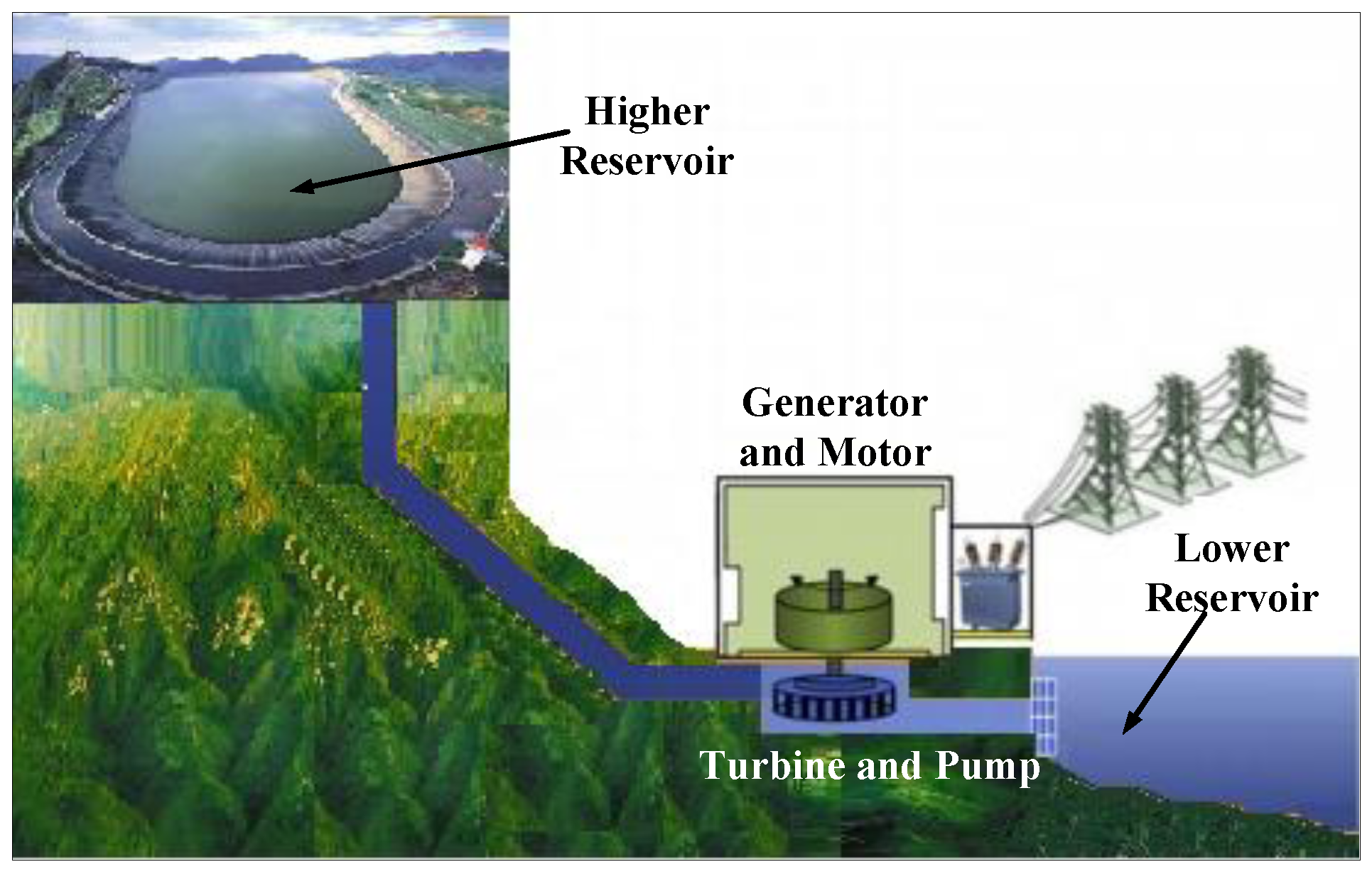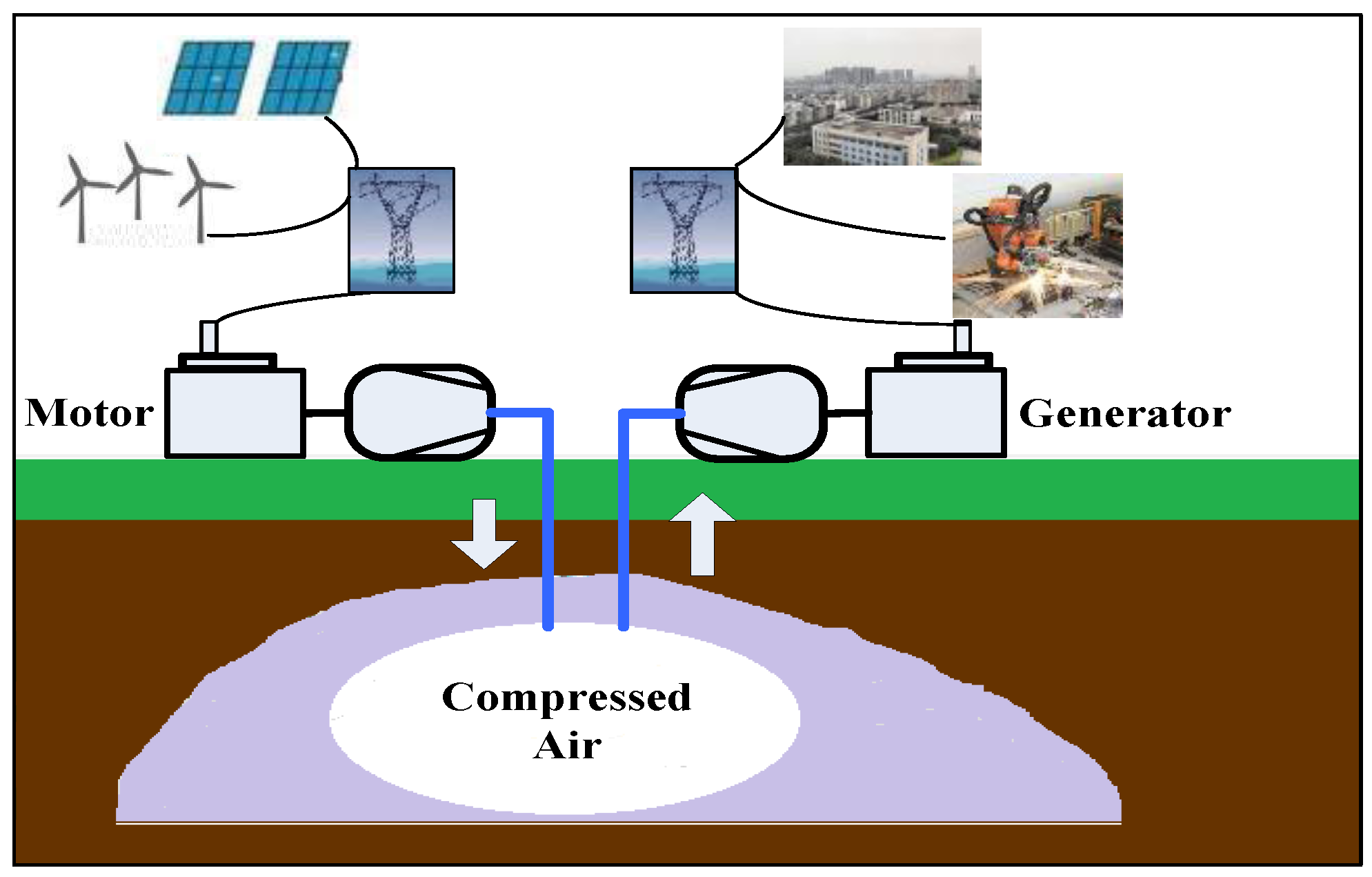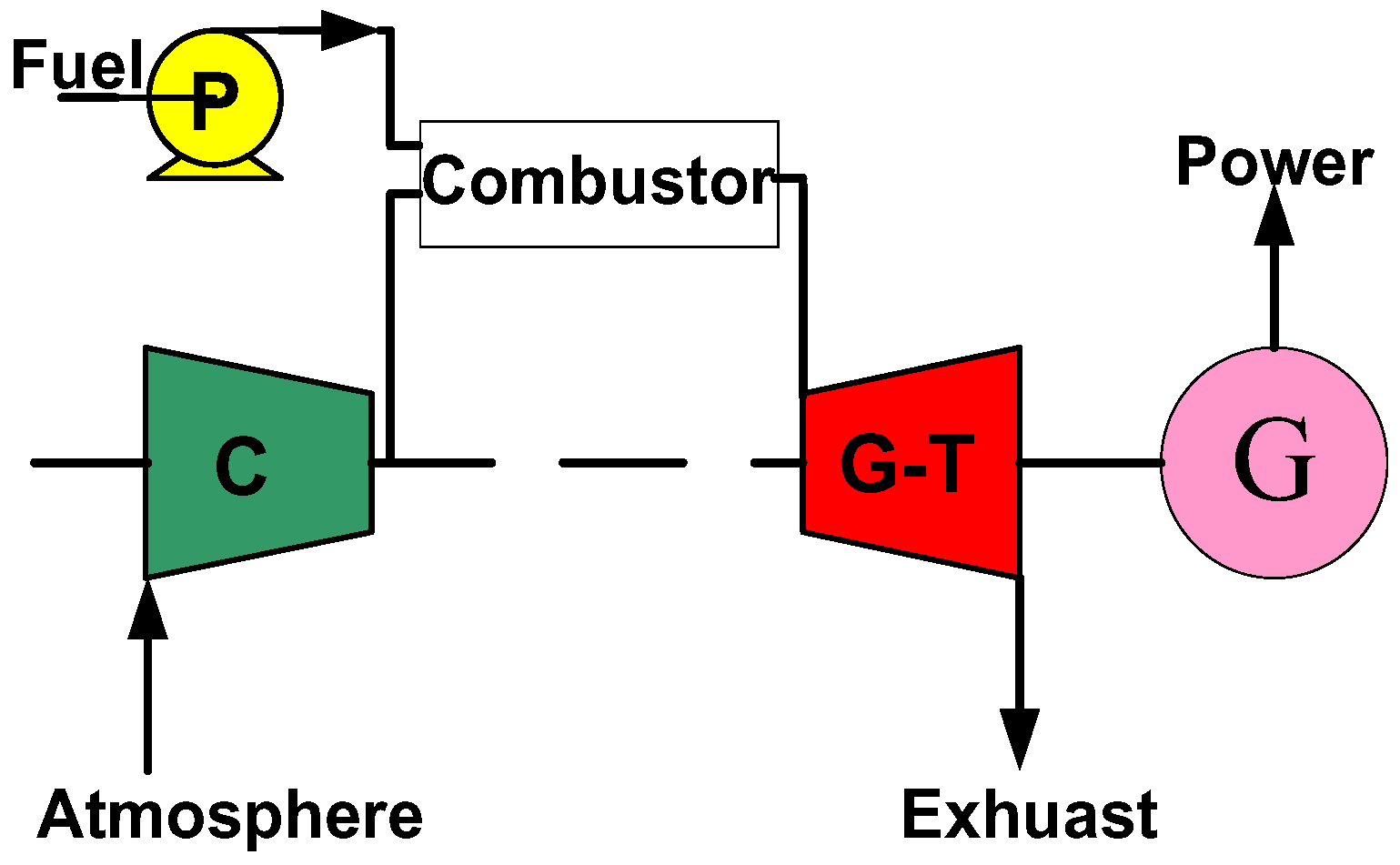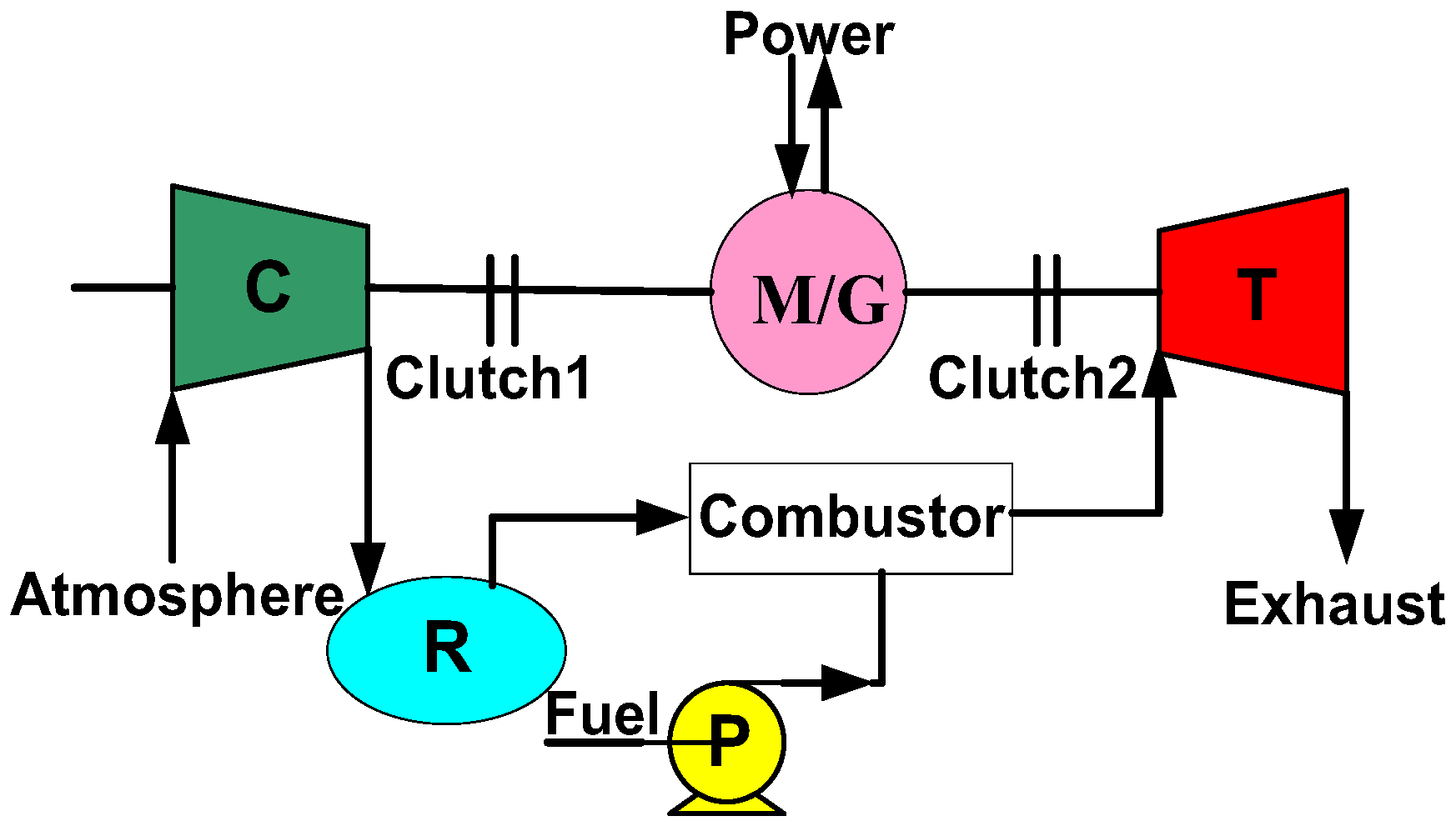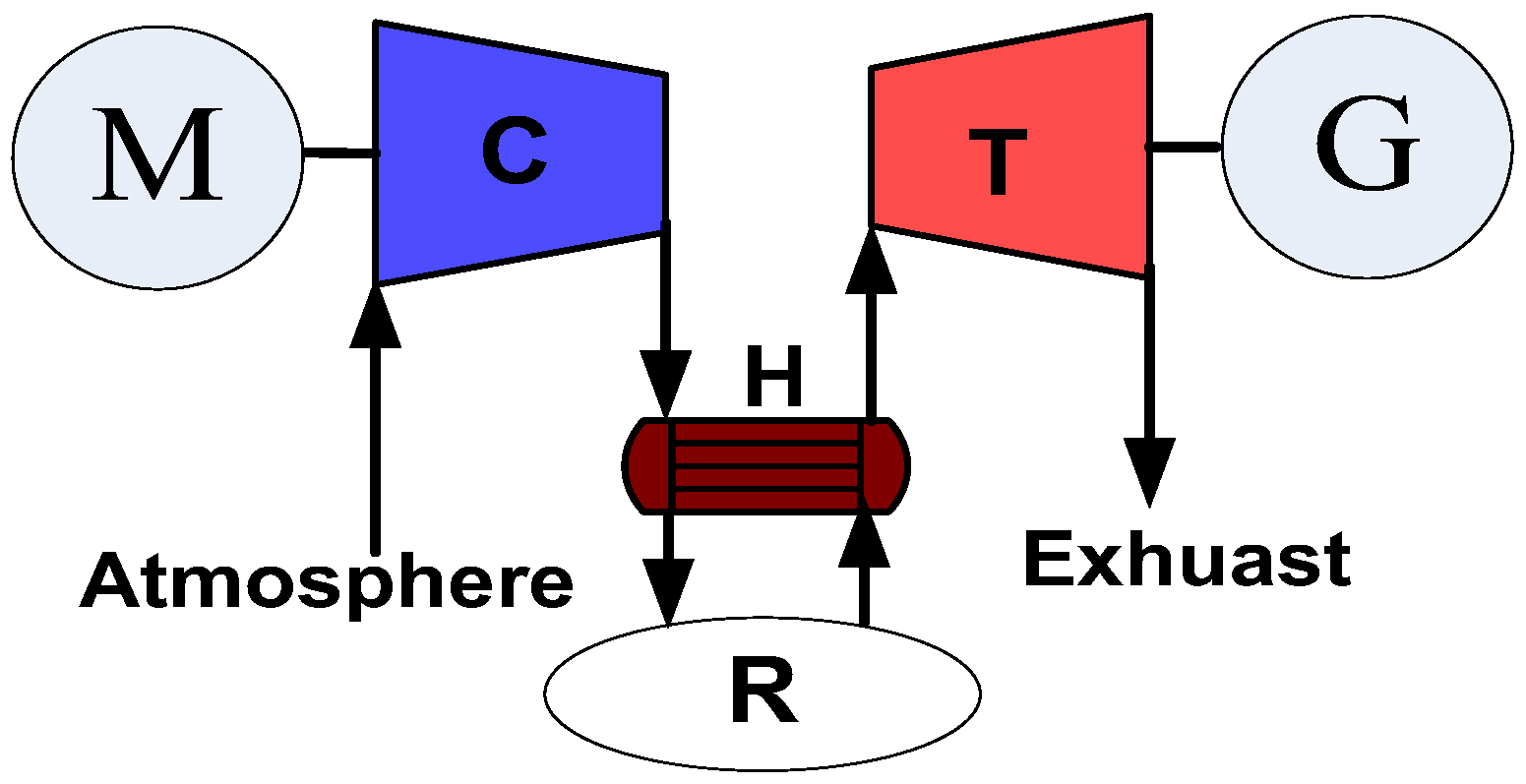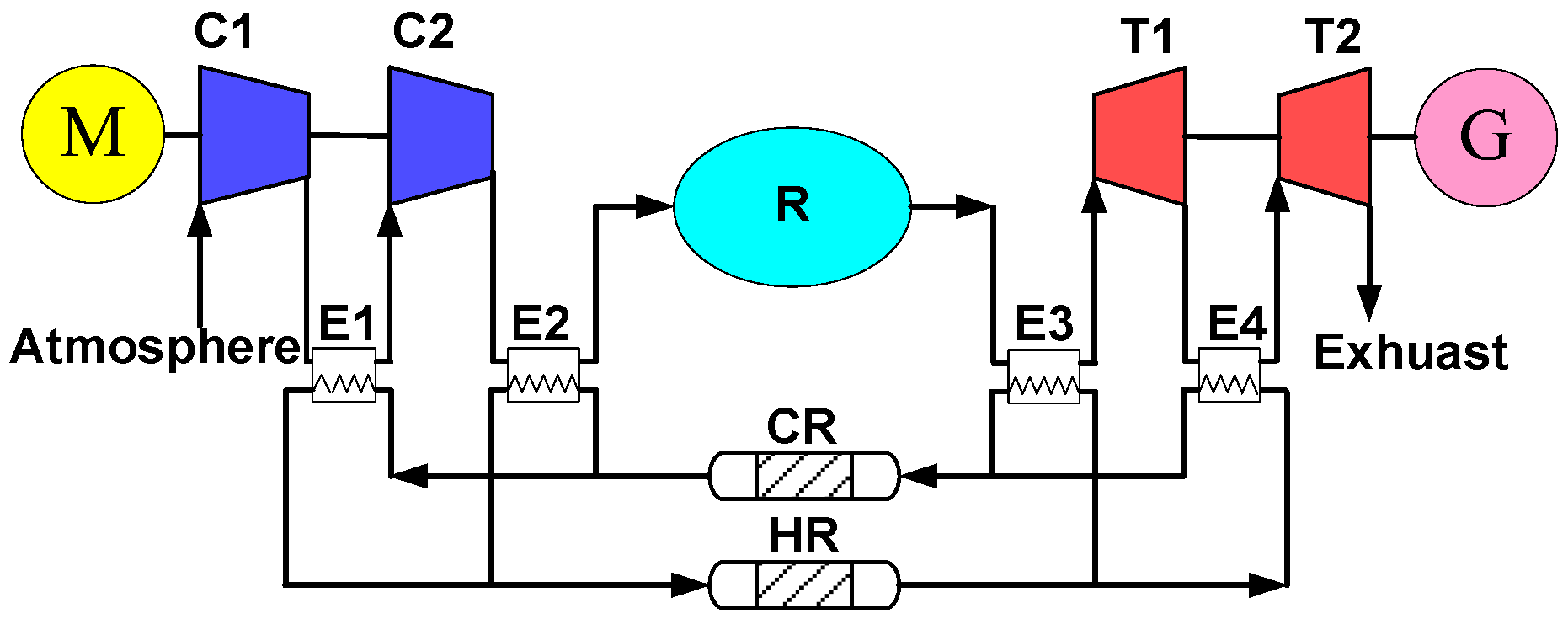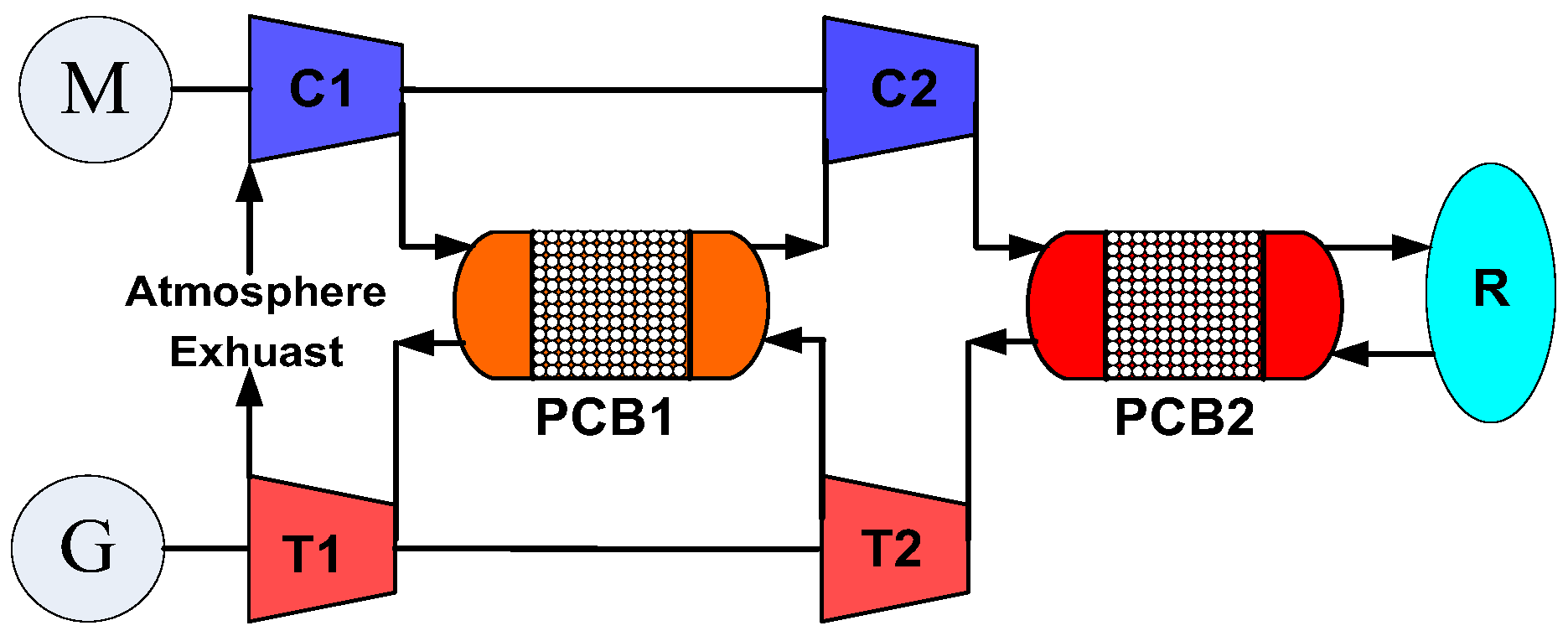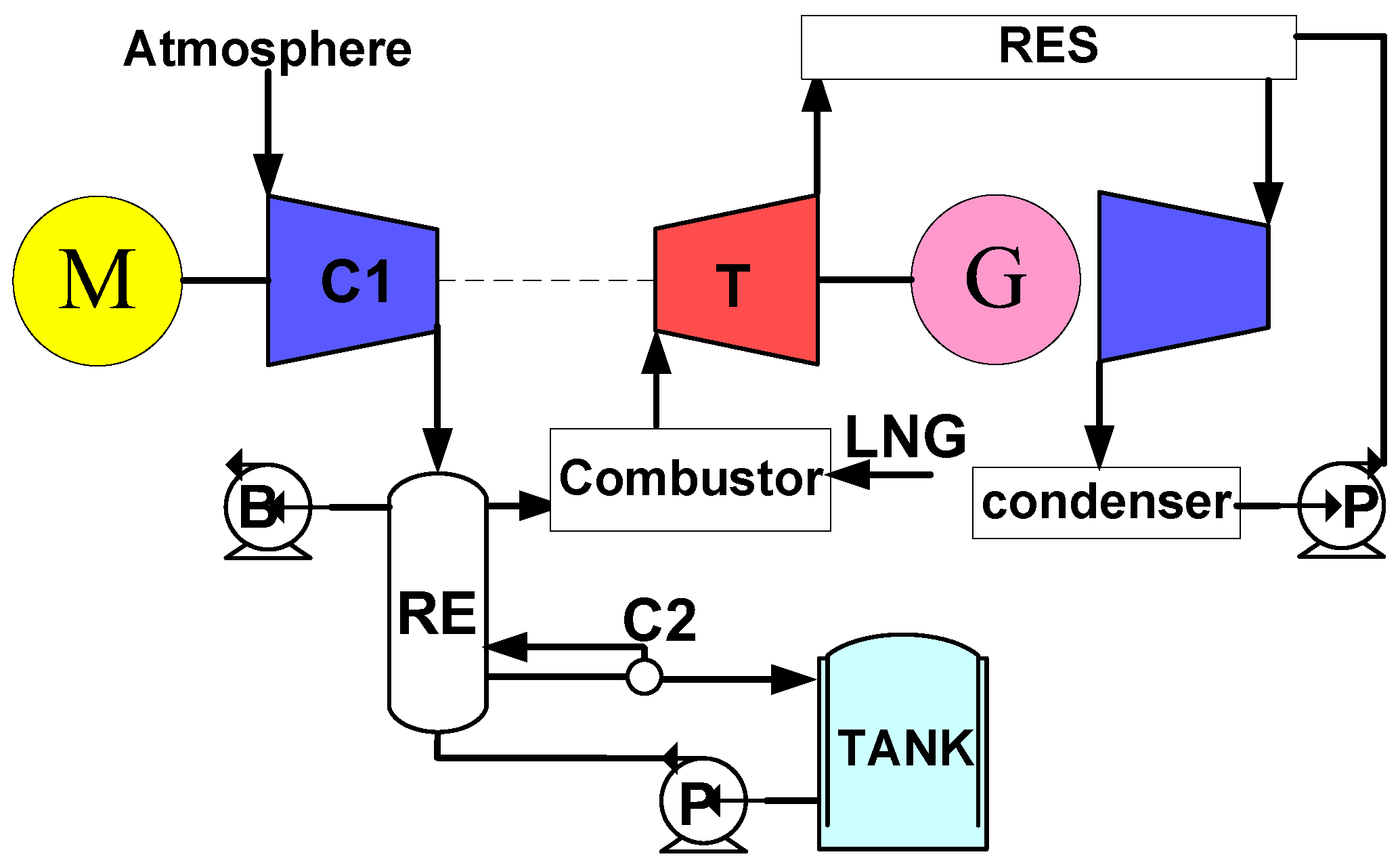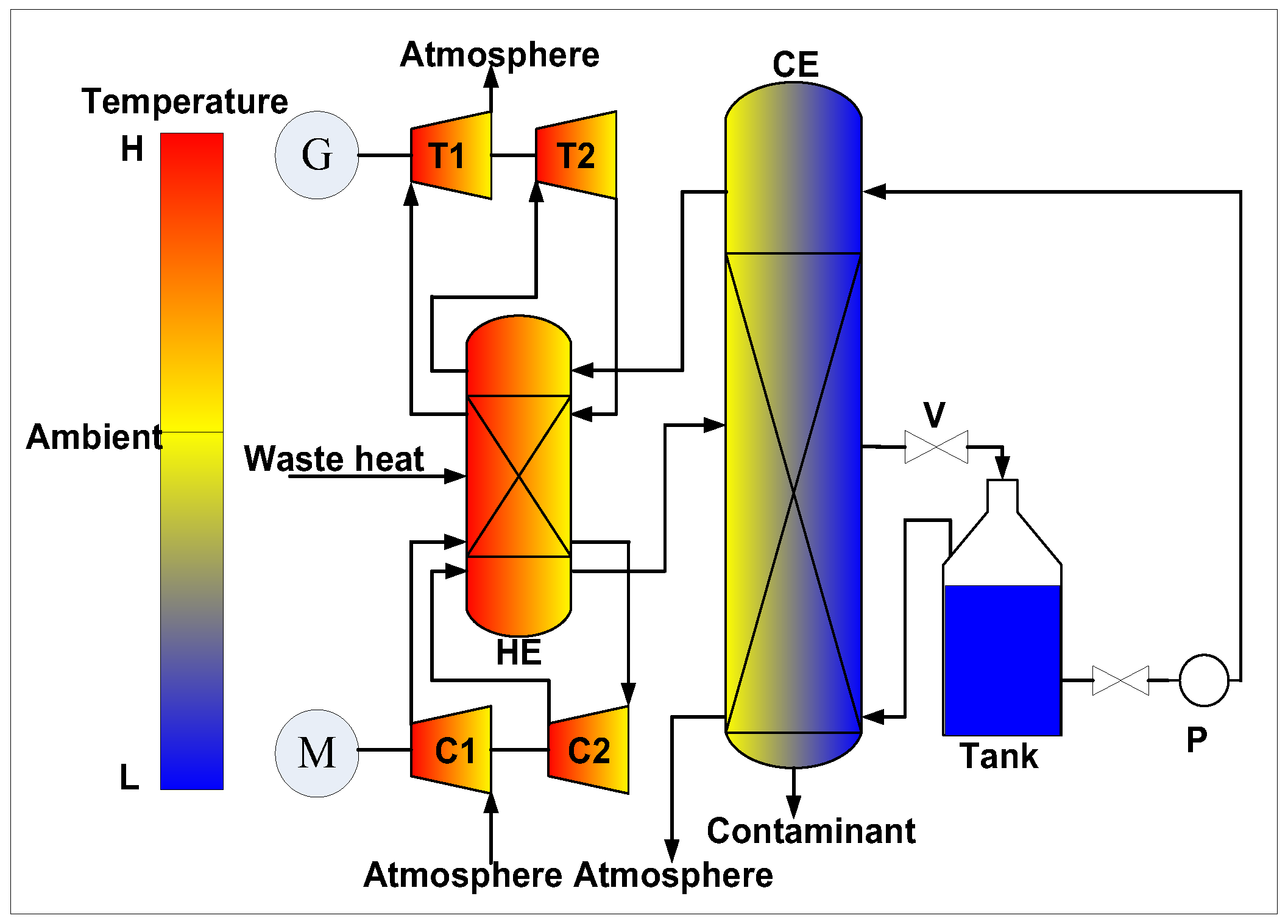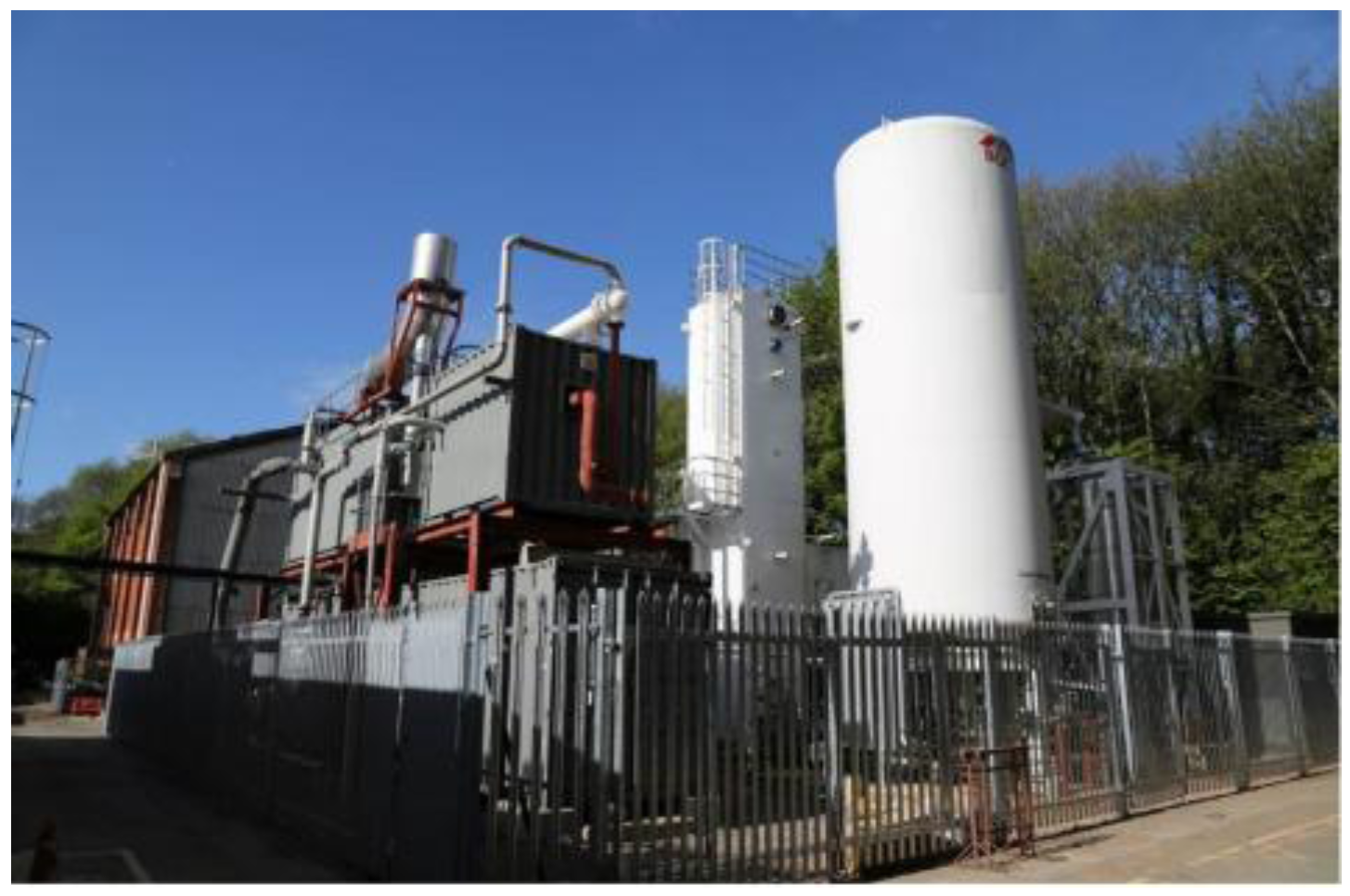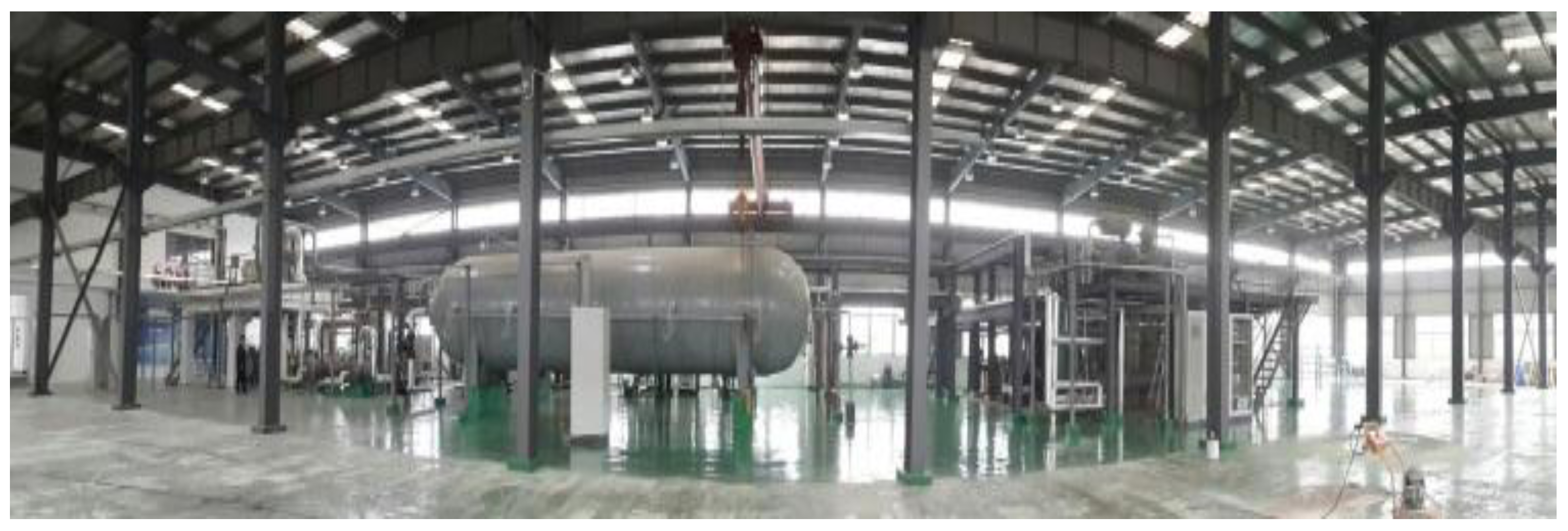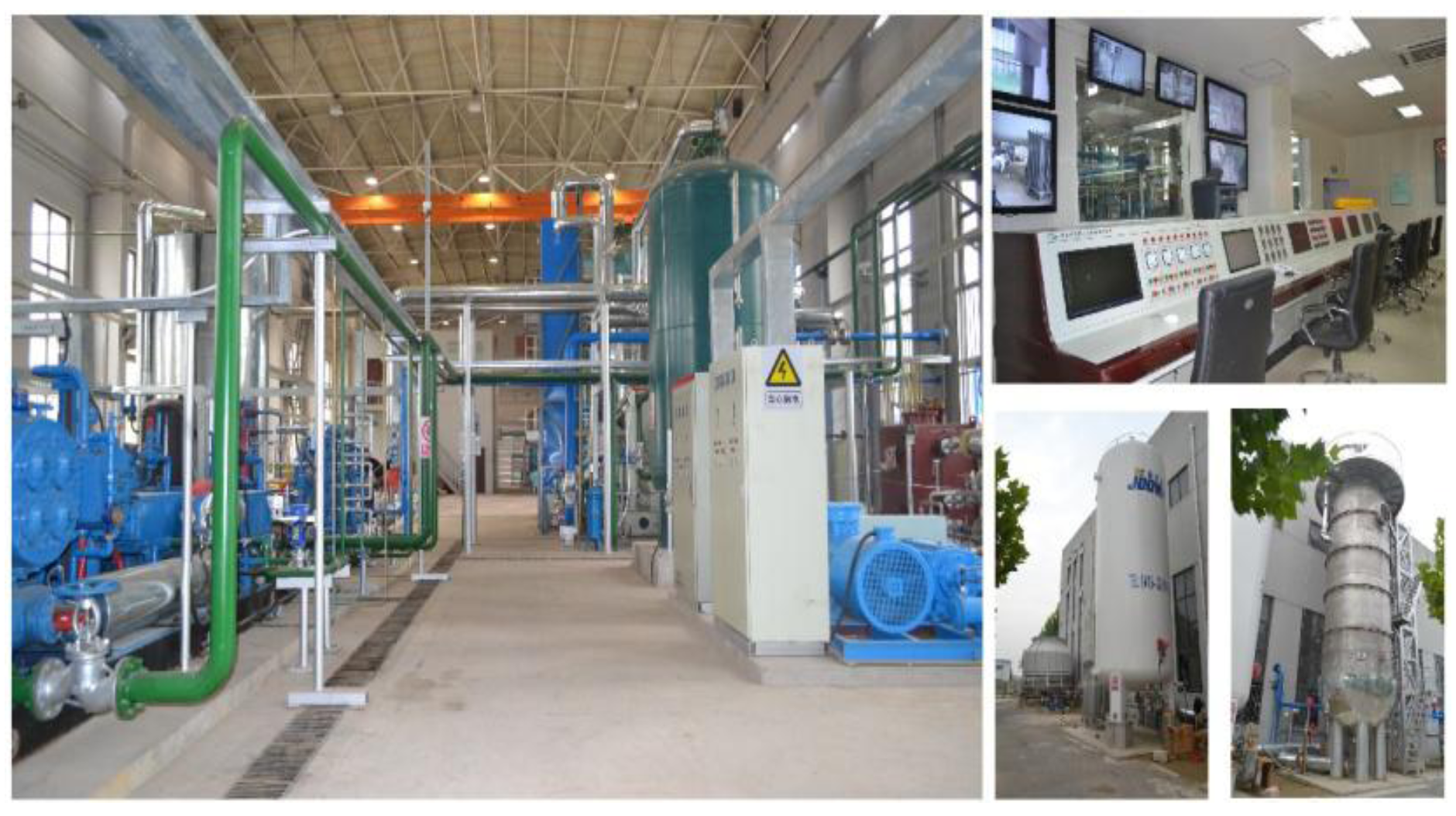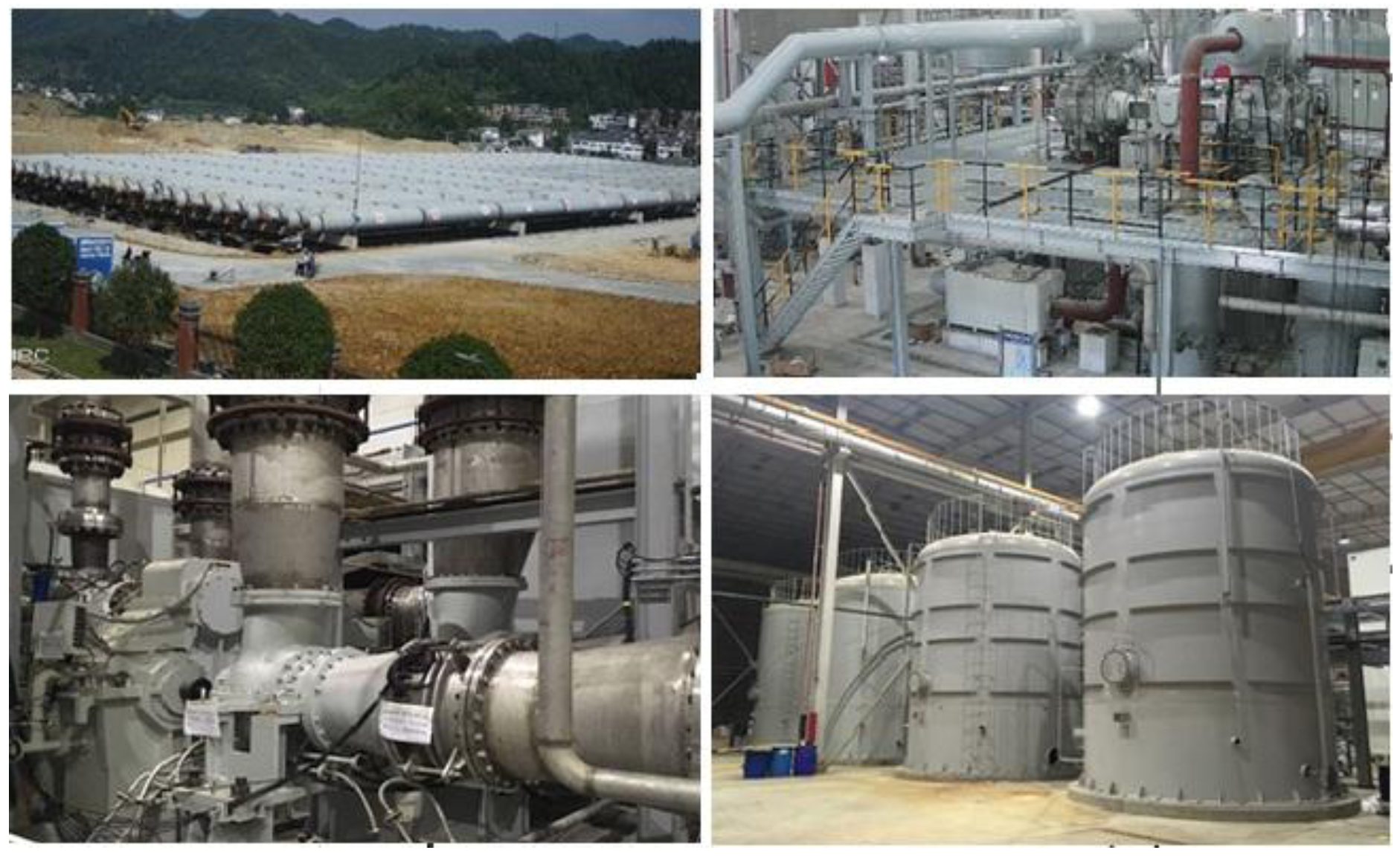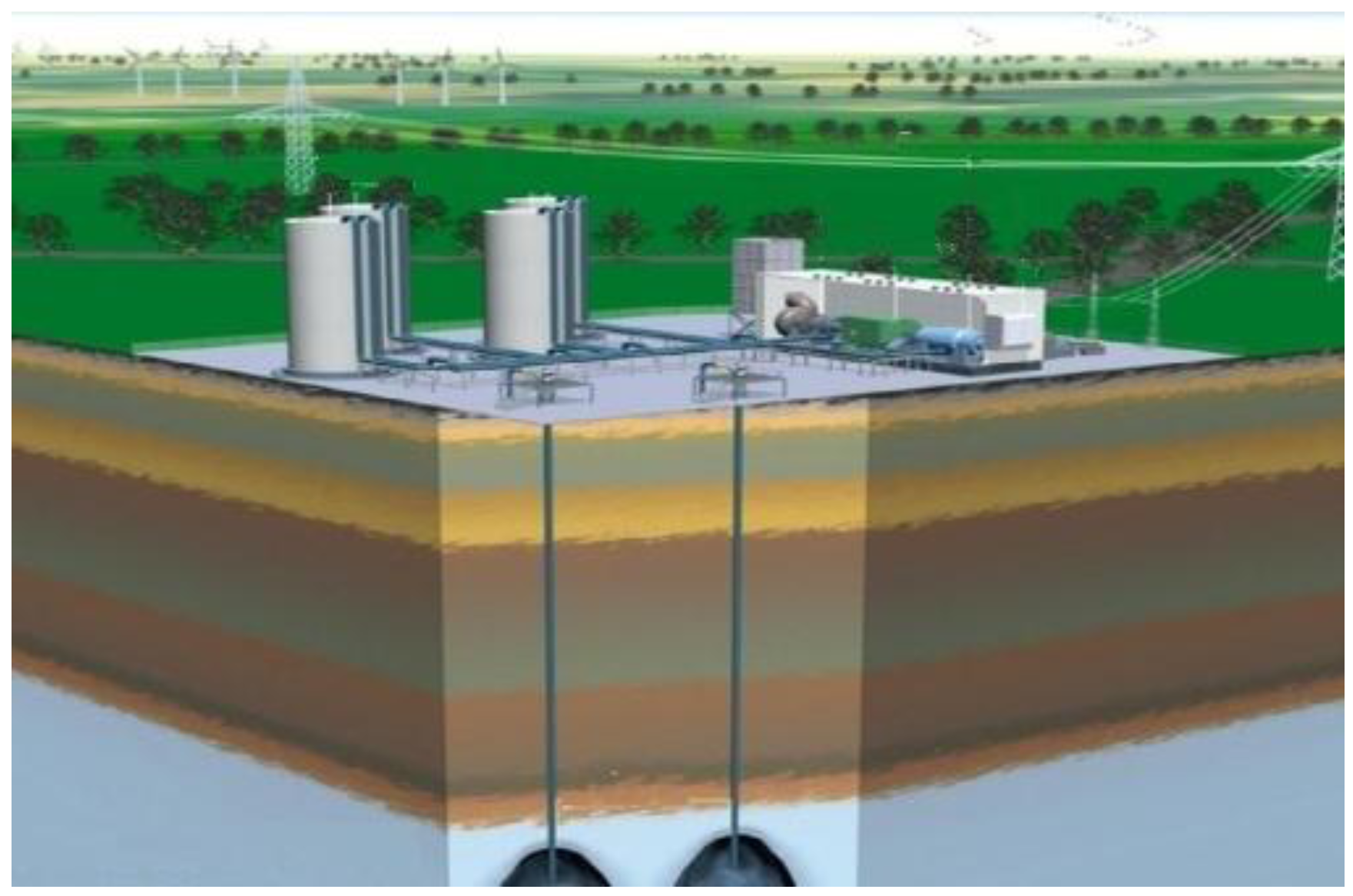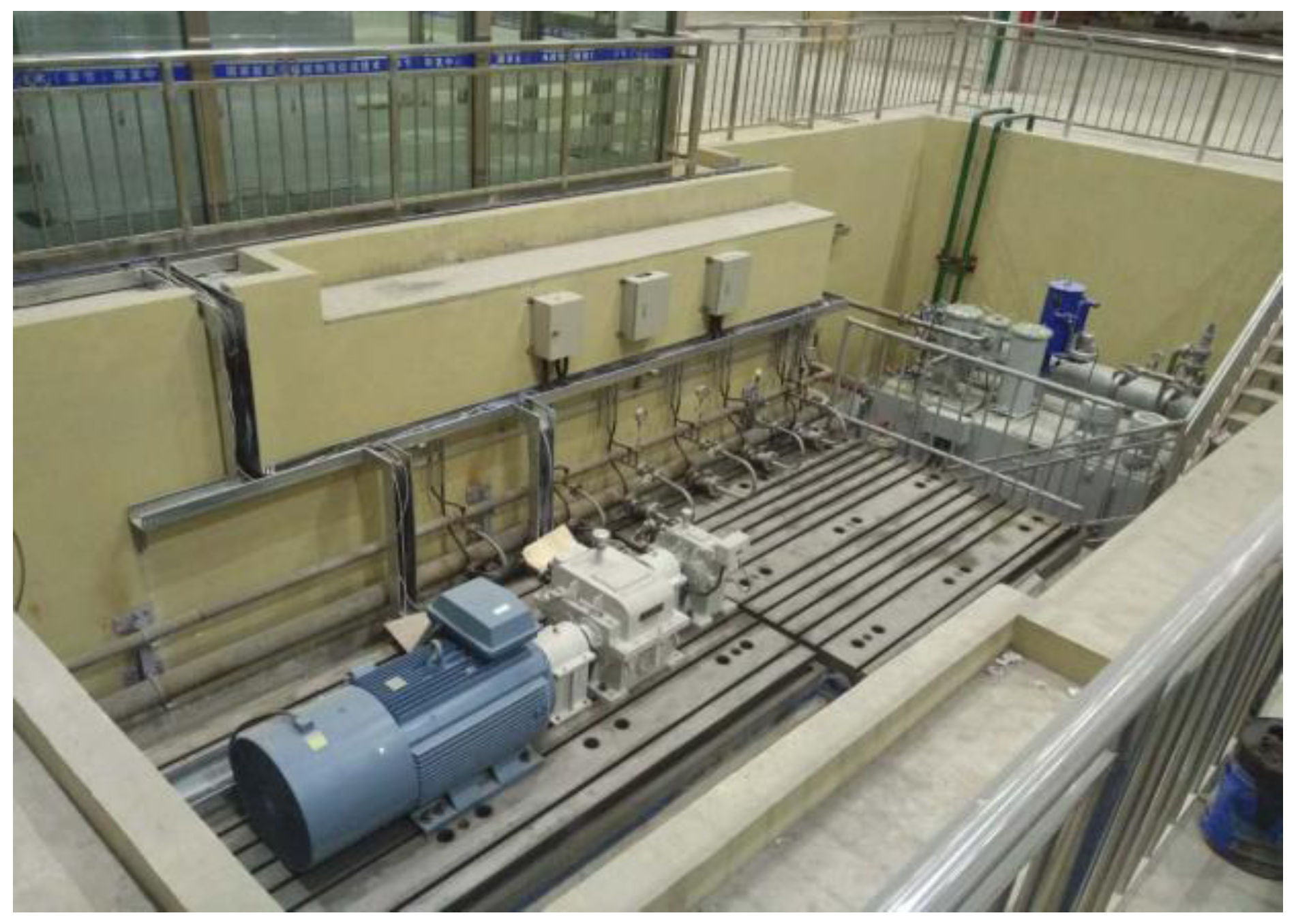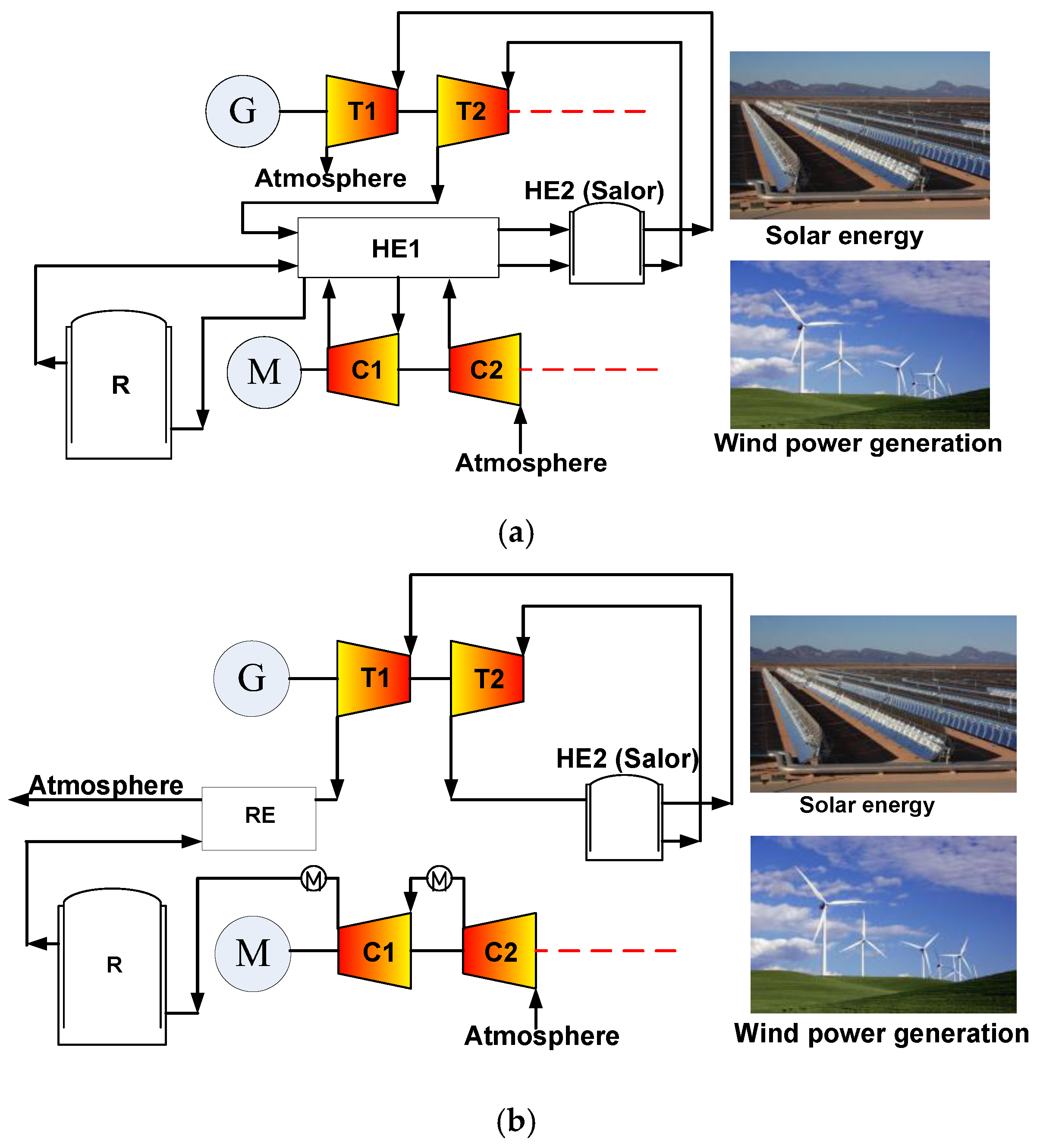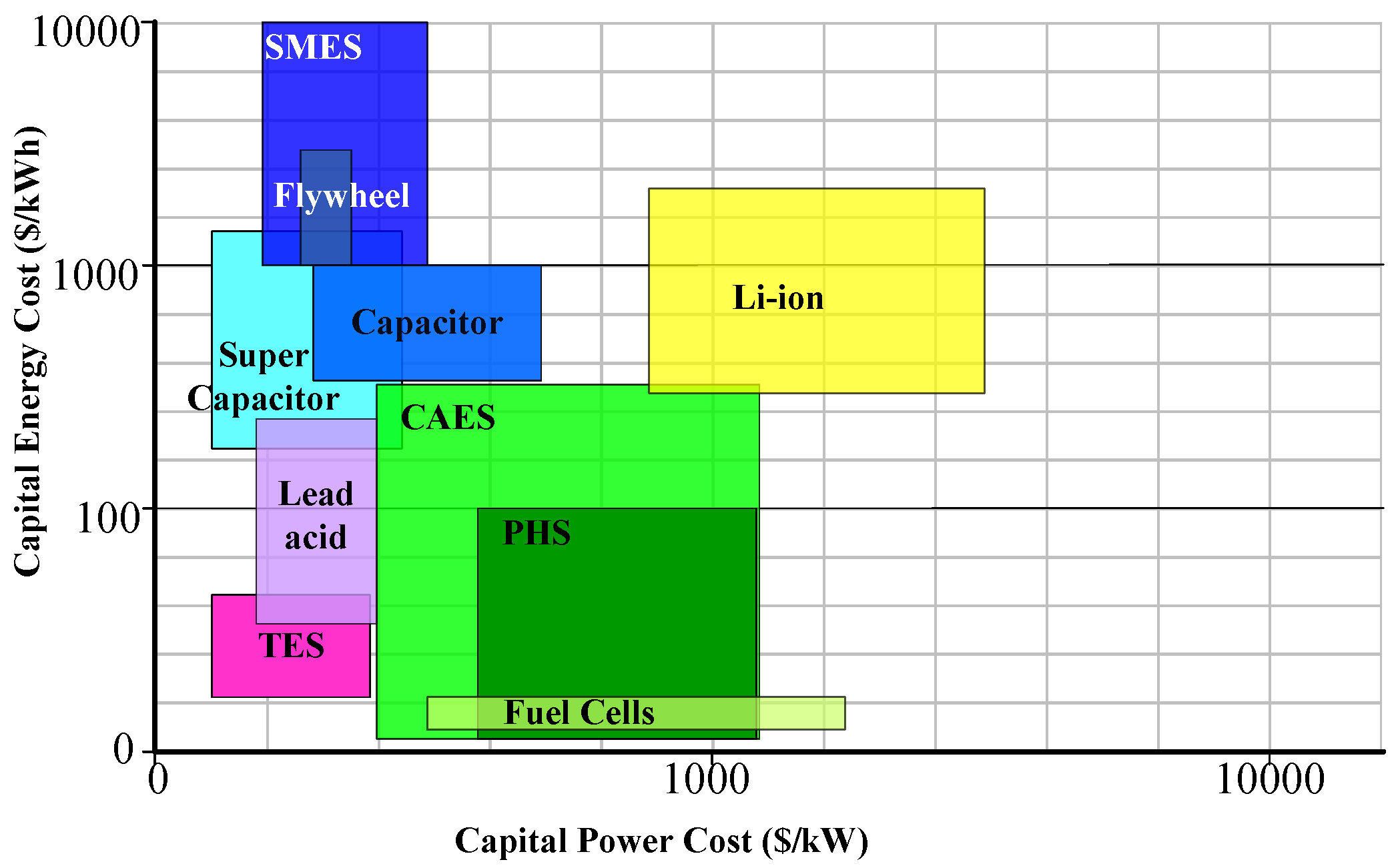1. Introduction
How to maintain economic growth and at the same time reduce the usage of fossil fuel for environmental protection is a global challenge. Various efforts are being made, mainly in two aspects: to reduce the energy consumption by improving energy efficiency and to explore clean and sustainable renewable energy sources [
1,
2]. Wind, solar and other alternative energy sources are being explored and rapidly developed. Wind power is considered as one of the renewable energy sources with a great development potential in the 21st century. However, the high-level penetration of wind power generation in the grid causes serious problems of power grid stability and reliability due to the intermittence and volatility of wind power. Suitable solutions are urgently needed and energy storage has been recognized as one of the most promising technologies for addressing the problems [
3,
4].
Energy storage, especially PHS, has a long history of being used for grid dispatching and peak shaving. Coal and gas reserves were historically considered as the major storage forms for flexible dispatch of energy. As technology developed, various feasible energy storage technological solutions have emerged on the market. At the ENERGY STORAGE CHINA 2016 conference, the China Energy Storage Alliance reported that China had 118 energy storage projects in operation (employing Li-ion, lead-acid and flow batteries, and excluding PHS, CAES and thermal energy storage). This represents 105.5 MW of installed capacity with a 110% (2010–2015) annual growth rate, meaning a predicated capacity of up to 24.2 GW (excluding PHS) and 40 GW (including PHS) by 2020 [
5].
Energy storage can be organized into several categories based on the nature of its operation and storage medium used: primary fuel (such as coal, oil storage, etc.), intermediate fuel (such as gas, hydrogen, etc.), electrical energy storage and other forms [
1]. The recent status of electrical energy storage technologies is presented in the
Table 1 [
6,
7,
8,
9,
10], and the cost of different energy storage technologies is shown in
Figure 1 [
6,
7,
8,
9,
10,
11], including the capital energy cost pitted against capital power cost.
In more detail, a meticulous comparative life cycle cost (LCC) analysis of electricity storage systems was provided by Zakeri and Syri, and the LCC of a CAES plant is highly dependent on fuel costs, emissions costs, and charging electricity prices [
11]. Comparing the investment cost, capacity, lifetime, energy density and storage duration, PHS and CAES are suitable for use in large-scale commercial applications where they are more economic [
6,
7,
8,
9,
10,
11,
12].
PHS, as shown in
Figure 2, is one of the most widely-used energy storage technologies, which has demonstrated its merits in terms of technological maturity, high cycle efficiency, large rated power, long service life and low operating cost, but the location choices are highly restricted, construction cycles are long, maintenance costs are high and it impacts the local environment, so the further utilization of PHS is limited [
13,
14,
15]. In addition to PHS, CAES is another feasible way to realize large-scale power storage. Since 1949 when Stal Laval proposed to store compressed air using underground caverns, the research in CAES has been progressing [
16]. Compared with PHS, CAES has relatively low impact on the environment and the cost of building a CAES plant is similar to the cost of PHS [
4,
15,
16,
17,
18,
19]. While PHS development has slowed down (or increased in difficulty), CAES has the potential to be an equivalent technology with its distinguishing advantages allowing it to take the place of PHS. Therefore, the article concentrates on the technology development and future trend in CAES.
2. Description of CAES Technologies
CAES refers to the energy stored in the form of high pressure compressed air and consumed in a different form of energy converted from the compressed air. In supporting power network operation, compressed air energy storage works by compressing air to high pressure using compressors during the periods of low electric energy demand and then the stored compressed air is released to drive an expander for electricity generation to meet high load demand during the peak time periods, as illustrated in
Figure 3.
CAES technology is based on the principle of traditional gas turbine plants. As shown in
Figure 4, a gas turbine plant, using air and gas as the working medium, mainly consists of three sections: gas turbine, compressor and combustor. Gas with high temperature and high pressure, which is formed by mixing compressed air and fuel in the combustion chamber, drives the turbine which in turn drives a generator to generate electricity [
20,
21]. For a CAES plant, as shown in
Figure 5, there are two different stages of operation, namely compression and expansion. Since the two stages do not run simultaneously, there is higher system efficiency (48–54%) than in traditional gas turbine systems. At present, two large scale commercial CAES plants involving gas fires are in operation. The first CAES plant was installed and commissioned for operation in Huntorf, in 1978 [
19]. It has a rated generation capacity of 290 MW for providing load following service and meeting the peak demand while maintaining the constant capacity factor of a nuclear power plant. In 1991, the second large-scale CAES plant commenced operation in McIntosh [
19]. This plant has a generation capacity of 110 MW, with a storage capacity of 2700 MWh, and is capable of continuously delivering its full power output for up to 26 h.
A whole CAES system has the following primary components: (1) compressors; (2) expanders; (3) air reservoirs; (4) combustor; (5) motor/generator; (6) controlling system; (7) other auxiliary equipment, such as fuel tanks, pipe connection and so on. Compressors, expanders and air reservoirs play decisive croles in the whole CAES system formulation, and the descriptions of each are presented below.
- (1)
Compressors and Expanders
Compressors and expanders are designed, or selected, according to the applications and the designed storage pressure of the air. The pressure of air in a vehicle cylinder can reach 30 MPa of storage pressure for higher energy storage density in a limited volume, so multi-stage reciprocating compressors are normally adopted. The pressure used for a large scale CAES system is about 8 MPa, for which multi-stage compressors are used, and normally combined axial flow compressors and centrifugal compressors are selected [
22,
23]. Similarly, the steam turbines in Huntorf are used for the first-level expansion from 4.6 MPa to 1.1 MPa; and gas turbines are utilized for the second-level expansion from 1.1 MPa to atmospheric pressure, in which the working medium is flue gas generated from the combustion of the air and fuel.
Large volume air reservoirs are required for large scale CAES systems, so fabricating large storage containers is a key factor. This is why the current operational CAES plants use underground caverns for storage, in particular, salt caverns. From recent research, suitable geological formations include underground salt layers, underground hard rock layers, and underground porous rock layers. In
Table 2, the capital cost of an air reservoir for various storage media and plant configurations are listed [
10]. The cost is related to the types of storage (containers/caverns), power rating and the duration of storage. Therefore, in
Table 2, the cost of power related components such as turbine, expander etc. is listed as
$/unit power and the cost of storage components such as underground caverns and over ground cylinders is related to their capacity and listed as
$/unit energy stored. At present, the two commercial CAES plants both adopt underground salt caverns as air storage reservoirs, with storage capacities of 310,000 m
3 (Huntorf) and 560,000 m
3 (McIntosh), respectively. In the formation and maintenance of salt caverns, some challenges are presented such as rat holes, the damage caused by small animals, the treatment of salt water, etc. [
24,
25].
The operation modes of an air reservoir are divided into sliding-pressure operation and constant-pressure operation.
Sliding-pressure operation with a constant volume: the rising pressure leads to a change of the pressure ratio of the compressors causing an increase in irreversible losses. Also, at the end of the discharge, there will be remnant air, which will reduce the efficiency of the whole system.
Constant-pressure operation at the charging and discharging stages: the compressors and expanders can keep the high efficiency under the rated conditions [
26].
4. Applications of CAES
Recently, the application prospects and the potential of CAES in supporting power system operation have become widely recognized. It is predicted that CAES will play an increasingly important role in the energy management of the time of separation between generation and the usage of power. The potential applications of CAES are generally considered twofold: suppliers and consumers (behind the meter). For the power supply side, the transmission and distribution network operators can use CAES for bulk energy rescheduling for maintaining the load balance. “Behind the meter” refers to the consumer side, that is, the users can use CAES to regulate the electricity usage taken from the suppliers based on the energy price to minimize their energy bill. The potential applications of CAES are explained below.
- (1)
Peak Shaving and Demand Side Management
For electric power enterprises, peak shaving means the process of storing energy during off-peak periods and compensating electrical power generation shortfalls during the periods of high demand. In the different price tariff periods associated to the peak and off-peak durations, users can use CAES to manage the demand side energy by storing energy at the lower price and releasing the stored electrical energy during the periods of higher electricity price. In this way, the consumers can reduce their electricity costs. Considering the durations of long and medium term storage, Wang et al., established a demand response dynamic analysis model, which can help the owners of CAES design a target incentive mechanism that can attract the support at the project development early stage and also estimate the potential operation revenue generation [
46]. Li et al., established an optimal time-of–use pricing response model, which can improve the load curve and obtain better resolution for load shifting effectively which is verified by many tests [
47].
- (2)
Integration of More Renewable Power Generation Plants
CAES can support the seamless integration of renewable power generation plants into the existing power network to realize the goal of stable power grids, which can help solve the problems of the inherent intermittence and instability of renewable power generation [
48]. In the micro-grid concept, CAES can rapidly suppress the micro-grid power fluctuations and improve power supply quality, which is important for the reliable operation of micro-grids [
49,
50]. Tang et al., established a simulation and experimental platform, including energy storage, photovoltaic, asynchronous wind turbines and typical load in micro-grids. The results from their study showed that effective control of energy storage could help micro-grids maintain good voltage and frequency stability during the switching process patterns of off-grid/grid pattern [
51].
- (3)
Applications to Smart-Grids and Wind Energy Network
Smart-grids, as the future direction and trend of the electric power industry, aim to achieve energy management in both directions, that is, from both supply and consumption with the support of internet and big data technology [
52,
53]. Traditionally, consumers have passively accepted the electricity supplied to them so it is a direction of supply and consumption relationship; however, smart-grids will transform this structure by involving the active selection of supply, integration of local generation and dispatching energy storage sources. Rifkin, a famous American economist, believed that energy internet would be the core in the third industrial revolution, which will have a great influence on the development of society [
54]. The energy internet is called smart-grid V2.0 by Li, et al., and energy storage is considered as the key enabling technologies of energy conversions and integrated applications [
2].
- (4)
Applications to Compressed Air Engines
The compressed air energy can be converted into other forms of mechanical energy through compressed air engines, which are mainly used in air-powered vehicles [
55,
56]. Chen et al., conducted a detailed review on the research and development of air-powered vehicles and pointed out that the current work should be focused on the principle and the structure optimization of air-powered automobile engines, the distribution forms and the control technology for reducing pressure [
55].
- (5)
Applications in Other Fields
In the case of power supply system failure, CAES systems can be used as a back-up power or uninterrupted power supply (UPS), which can supply adequate power to important users, such as banks, data processing centers, hospitals and other important sectors [
6,
19]. CAES systems could provide the capacity of black-start in a power shutdown condition. For example, the Huntorf plant offers black-start power to the nuclear units located near the North Sea [
57].
6. Future Development of CAES Technology
CAES has demonstrated its unique merits and advantages but it has also shown its weakness in terms of low round trip efficiency and lower energy density. The future technology development is currently focusing on improving its efficiency. Such technology developments are presented here.
6.1. Optimal Design of Turbo Machinery
Innovations and breakthroughs are important in the technologies concerned with high-pressure compressors and turbines, which are the core components in the whole CAES systems. Due to the higher operation pressure than those used in gas turbine plants, the internal leakage and energy losses are the key factors in reducing the efficiency and as such are seriously addressed future development research.
- (1)
Compressors
Although the manufacturing technology of compressors is relatively mature, the coupling relationship and the control strategy with air receivers can improve the system efficiency further. Corvaro and his team studied the procedures, which integrated the reliability, availability and maintainability (RAM) into manufacturing reciprocating compressors API 618. The ultimate aim of the procedure is devoted to on-site measurement and real data acquisition under working conditions [
69]. The heat transfer enhancement is also an advanced research focus. As shown in
Figure 16, Zhang et al., employed the “open accumulator” in a fluid power wind turbine system. To achieve the efficient compression and expansion under near-isothermal conditions, the team inserted porous media in the compressor’s chamber, such as foams and interrupted-plate inserts. The computational results confirmed that inserts were very effective in suppressing temperature rises during compression [
70].
- (2)
Turbines/Expanders
Table 6 presents a review of expanders. Expanders, in general, can be categorized in two types: velocity type, such as axial turbine expanders; and volume type, such as screw expanders, scroll expanders, and reciprocal piston expanders [
71].
Xue adopted a single valve piston expander and formulated the mathematical models for different projects of miniature CAES with the assumption of 14.8 MPa of storage pressure which are reported in the literature. The best project of the miniature CAES systems can be obtained: when the pressure of inlet air is lower than the rated pressure, it will be injected into the expander until the indicated work less than the friction power of single piston cylinder [
72]. Wang has conducted comprehensive research on scroll expanders, including scroll formation, chamber volumes and output torque calculations, and the energy conversion efficiency of scroll expanders was analyzed and showed high energy efficiency on the basis of complete dynamic mathematical model [
73,
74].
During the expansion process, the rotating speed of a turbine is high, so the stability of the rotor is crucial. For example, when the frequency of the turbine is designed near to the first order critical speed and the second order critical speed, there will be strong vibration and noise, even leading to the instability of the high-speed rotor and the damage of the rotor bearing systems.
A multhe ti-axis coupling and high-speed rotor dynamic test platform was designed and built in 2017, by Chinese Academy of Sciences Institute of Engineering Thermophysics. It consists of a power system, lubrication system, control system, vibration system and other miscellaneous parts, and the transmission ratio could be up to 30 and the highest rotational speed could be up to 45,000 r/min (
Figure 17). Through the platform, experiments of multi-rotors structure dynamics of large scale CAES and multi-axis high-speed machines can be carried out [
75].
6.2. Thermal Storage and Cold Storage
Applications of Thermal Energy Storage (TES) have been found in the building industry, the automotive industry and solar energy installation. Recently, more applications are being explored, such as integration of TES with CAES, recycling industrial waste heat, and emissions reduction via replacing non-renewable energy. Generally, TES could be considered to have two kinds, that is, heat energy storage (HES) and cold energy storage (CES) [
76]. TES includes the sensible heat storage and the latent heat storage: the sensible heat storage (SHS) uses the heat capacity of the materials for storage/release of heat; the latent heat storage (LHS) uses phase change materials (PCM) to achieve heat storage/release heat.
Compared with the SHS, there are many advantages of LHS, such as high-heat storage capacity, constant heat source at the phase-changing temperature point, and the reversible phase-changing process for repeated uses [
76,
77,
78,
79]. Reference [
76] concludes that the choice of storage material depends on the desired temperature range, applications of the thermal storage unit and the size of thermal storage system. As shown in
Table 7, there are three kinds of phase change materials that could meet the high-temperature requirements: organic, molten salts, and alloys [
77]. PCMs for cold thermal energy storage (less than 20 °C) applications are reviewed in [
79] and the results are listed in
Table 8. The composites are also reported in many publications and applications [
80,
81]. Li et al., has researched the heat transfer behavior of thermal energy storage components using composite phase change materials, and established a mathematical model considering different material properties and geometrical designs, which showed a reasonably good agreement with the experimental data [
81].
For sophisticated CAES systems, TES, as a subsystem for reusing the compression heat energy and the expansion cold energy to enhance the round-trip efficiency, is attractive for both research and industry. The research reports in this area have rapidly increased in recent years. For example, cold thermal energy storage is considered to be a cornerstone role in LAES, and its impact on future commercial scale LAES plants is addressed by Sciacovelli, Vecchi and Ding through studying a 100 MW/300 MWh standalone LAES plant with SHS through the LAES pilot plant in the University of Birmingham [
59].
6.3. Integrated and Hybrid CAES Systems
- (1)
Integration of CAES with Renewable Energy
CAES systems can solve some problems effectively. As shown in
Figure 18a,b, Xu and Chen presented a new coupling scheme with complementary wind and solar elements, which use the compression heat, exhaust waste heat, and solar energy instead of traditional gas heating, in order to improve the overall efficiency of the system [
4]. Sun et al., built a new mathematical integration model of wind power and CAES systems, and indicated that the efficiency of the system could be up to 55% under a well-controlled operation condition [
82]. Minutillo et al., accessed the optimal operating parameters of the integration system of AA-CAES and a photovoltaic power system in terms of average storage pressure and operating pressure range of the air tank [
83]. Ghalelou et al., proposed a stochastic self-scheduling program of renewable energy sources (RESs) considering CAES based on a demand response mechanism. The incorporation of CAES and demand response program could help the decision maker to reduce the expected operation cost, which was verified by the optimization models considering the market price, load, wind speed, temperature and irradiance [
48]. A two stages optimization method is proposed in order to minimize the system operational costs including thermal power units operation cost, wind power and photovoltaic power curtailment cost and price-based demand response scheduling costs by Li et al. [
84,
85].
- (2)
Integration with Gas Turbine
When air pressure is within 1–2 MPa, compressed air and fuel are sprayed into the combustion chamber, and high temperature gas with high pressure drives the gas turbine which in turn drives the generator to generate electricity [
26]. Bai et al., established a mode for coordinated control of micro grids with micro gas turbines and energy storage systems; the simulation results showed that the coordinated control model could guarantee seamless switching [
86]. Amin designed a new system for domestic applications, in which a micro gas turbine, a CAES system and a solar dish collector are integrated. The new system could achieve higher exergy efficiency (up to 53.36%) than systems’ efficiencies presented in available literatures [
87]. Li et al., designed a set of CAES systems for remote areas integrated with off-grid diesel generating systems. There were three main parts in the system: a diesel engine, a piston compressor and an expander. The coupling system could not only meet the needs of energy transformation, but also generate more electricity because of the recovery of waste heat [
88]. A zero-carbon-emission energy internet architecture to utilize power and heat in an integrated manner was proposed. A typical 1 MW non-supplementary fired CAES (NSF-CAES) hub was designed to show the effectiveness of the proposed NSF-CAES dispatch model in reducing operation cost, considering the pressure behaviors and temperature dynamics [
89].
- (3)
Integration with Solid Oxide Fuel Cells (SOFCs)
The integration of SOFCs (to provide base-load power) and a CAES system (to follow peaking demand) with zero direct CO
2 emissions was proposed by Nease and Adams. It was found that the integrated system could provide satisfying load-following capabilities with relatively small penalties to efficiencies and levelized electricity costs [
90,
91]. To solve the limitation of SOFC output and the finite of CAES storage capacity, a two-level rolling horizon optimization scheme was also presented by Nease, Monteiro and Adams [
92].
- (4)
Integration with Other Systems
There are many complicated integrated CAES systems, such as fuel engine, refrigeration system, etc. in order to improve the overall system and energy conversion efficiency. The integrated system with the fuel engine mainly provides hybrid power for vehicles to improve their efficiency, which could also boost the output power of the vehicles simultaneously [
93,
94].
